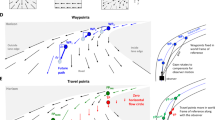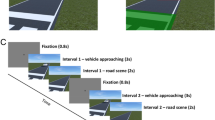Abstract
Looking at the inside edge of the road when steering a bend seems to be a well-established strategy linked to using a feature called the tangent point. An alternative proposal suggests that the gaze patterns observed when steering result from looking at the points in the world through which one wishes to pass. In this explanation fixation on or near the tangent point results from trying to take a trajectory that cuts the corner. To test these accounts, we recorded gaze and steering when taking different paths along curved roadways. Participants could gauge and maintain their lateral distance, but crucially, gaze was predominantly directed to the region proximal to the desired path rather than toward the tangent point per se. These results show that successful control of high-speed locomotion requires fixations in the direction you want to steer rather than using a single road feature like the tangent point.


Similar content being viewed by others
References
Billington J, Field DT, Wilkie RM, Wann JP (2010) An fmri study of parietal cortex involvement in the visual guidance of locomotion. J Exp Psychol Hum Percept Perform (in press)
Fajen BR, Warren WH (2003) Behavioral dynamics of steering, obstacle avoidance, and route selection. J Exp Psychol Hum Percept Perform 29(2):343–362
Field DT, Wilkie RM, Wann JP (2007) Neural systems in the visual control of steering. J Neuroscience 27(30):8002–8010
Gibson JJ (1958) Visually controlled locomotion and visual orientation in animals. Br J Psychol 49(3):182–194
Gibson JJ (1986) The ecological approach to visual perception. Erlbaum, Hillsdale, NJ (Original work published in 1979)
Kandil FI, Rotter A, Lappe M (2009) Driving is smoother and more stable when using the tangent point. J Vision 9(1):11
Kim NG, Turvey MT (1999) Eye movements and a rule for perceiving direction of heading. Ecol Psychol 11(3):233–248
Kim NG, Fajen BR, Turvey MT (2000) Perceiving circular heading in no canonical flow fields. J Exp Psychol Hum Percept Perform 26(1):31–56
Land MF, Furneaux S (1997) The knowledge base of the oculomotor system. Philos Trans R Soc Lond B Biol Sci 352(1358):1231–1239
Land MF, Hayhoe M (2001) In what ways do eye movements contribute to everyday activities? Vision Res 41(25–26):3559–3565
Land M, Horwood J (1995) Which parts of the road guide steering? Nature 377(6547):339–340
Land MF, Lee DN (1994) Where we look when we steer. Nature 369(6483):742–744
Land MF, McLeod P (2000) From eye movements to actions: how batsmen hit the ball. Nat Neurosci 3(12):1340–1345
Robertshaw KD, Wilkie RM (2008) Does gaze influence steering around a bend? J Vision 8(4:18):1–13
Royden CS, Banks MS, Crowell JA (1992) The perception of heading during eye movements. Nature 360(6404):583–585
Salvucci DD, Gray R (2004) A two-point visual control model of steering. Perception 33(10):1233–1248
Wann JP, Swapp DK (2000) Why you should look where you are going. Nat Neurosci 3(7):647–648
Warren WH Jr, Kay BA, Zosh WD, Duchon AP, Sahuc S (2001) Optic flow is used to control human walking. Nat Neurosci 4(2):213–216
Wilkie RM, Wann JP (2002) Driving as night falls: the contribution of retinal flow and visual direction to the control of steering. Curr Biol 12(23):2014–2017
Wilkie RM, Wann JP (2003a) Controlling steering and judging heading: retinal flow, visual direction, and extra retinal information. J Exp Psychol Hum Percept Perform 29(2):363–378
Wilkie RM, Wann JP (2003b) Eye-movements aid the control of locomotion. Journal of Vision 3(11):677–684
Wilkie RM, Wann JP (2005) The role of visual and nonvisual information in the control of locomotion. J Exp Psychol Hum Percept Perform 31(5):901–911
Wilkie RM, Wann JP (2006) Judgements of path not heading guide steering. J Exp Psychol Hum Percept Perform 32(1):88–96
Wilkie RM, Wann JP, Allison RS (2008) Active gaze, visual look-ahead and locomotor control. J Exp Psychol Hum Percept Perform 34(5):1150–1164
Wilkie RM, Wann JP, Allison RS Modelling locomotor control: the advantages of mobile gaze. ACM Trans Appl Percept (in press)
Acknowledgments
Georgios Kountouriotis was funded by an EPSRC PhD studentship. Thanks to Prof. Mark Mon-Williams and Dr Clare Harley for providing suggestions on earlier versions of this manuscript. Research supported by EPSRC UK Grant EP/D055342/1.
Author information
Authors and Affiliations
Corresponding author
Rights and permissions
About this article
Cite this article
Wilkie, R.M., Kountouriotis, G.K., Merat, N. et al. Using vision to control locomotion: looking where you want to go. Exp Brain Res 204, 539–547 (2010). https://doi.org/10.1007/s00221-010-2321-4
Received:
Accepted:
Published:
Issue Date:
DOI: https://doi.org/10.1007/s00221-010-2321-4




